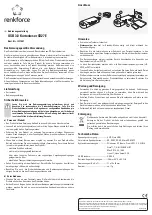
APPENDIX D
PCI-1711/1731 User’s Manual
Advantech Co., Ltd.
www.advantech.com
– 54 –
2. Writing to the second byte starts the new count.
MODE 1 – Programmable One-shot Pulse
The output is initially high. The output will go low on the count
following the rising edge of the gate input. It will then go high on the
terminal count. If you load a new count value while the output is low,
the new value will not affect the duration of the one-shot pulse until
the succeeding trigger. You can read the current count at any time
without affecting the one-shot pulse. The one-shot is retriggerable,
thus the output will remain low for the full count after any rising edge
at the gate input.
MODE 2 – Rate Generator
The output will be low for one period of the input clock. The period
from one output pulse to the next equals the number of input counts in
the counter register. If you reload the counter register between output
pulses, the present period will not be affected, but the subsequent
period will reflect the value.
The gate input, when low, will force the output high. When the gate
input goes high, the counter will start from the initial count. You can
thus use the gate input to synchronize the counter.
With this mode the output will remain high until you load the count
register. You can also synchronize the output by software.
MODE 3 – Square Wave Generator
This mode is similar to Mode 2, except that the output will remain high
until one half of the count has been completed (for even numbers), and
will go low for the other half of the count. This is accomplished by
decreasing the counter by two on the falling edge of each clock pulse.
When the counter reaches the terminal count, the state of the output is
changed, the counter is reloaded with the full count and the whole
process is repeated.
If the count is odd and the output is high, the first clock pulse (after
the count is loaded ) decrements the count by 1. Subsequent clock
pulses decrement the count by 2. After time-out, the output goes low
and the full count is reloaded. The first clock pulse (following the
reload) decrements the counter by 3. Subsequent clock pulses
decrement the count by two until time-out, then the whole process is
repeated. In this way, if the count is odd, the output will be high for
(N+1)/2 counts and low for (N-1)/2 counts.



































